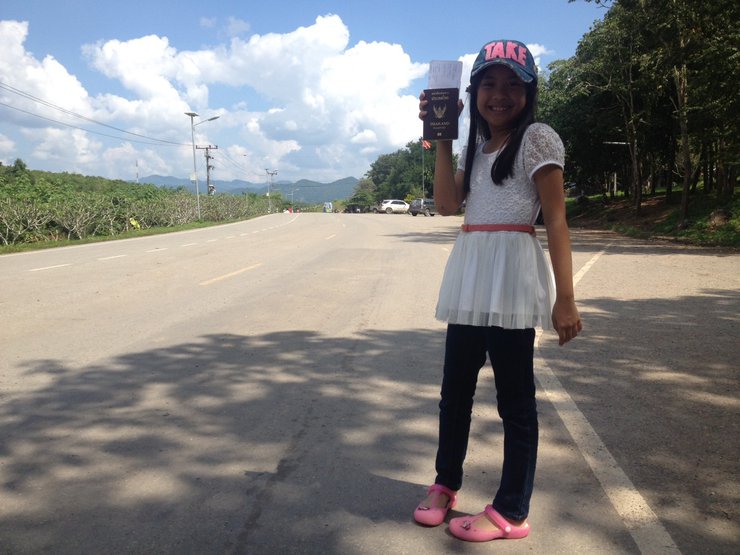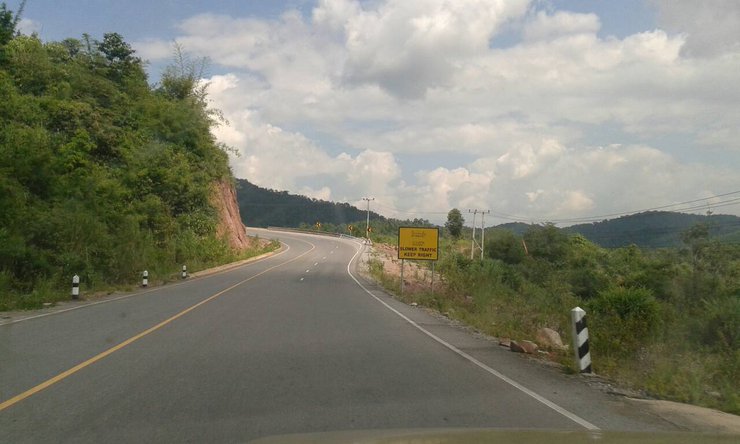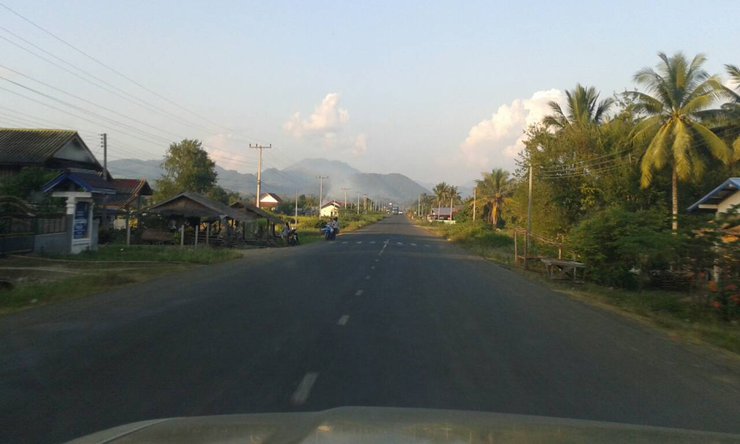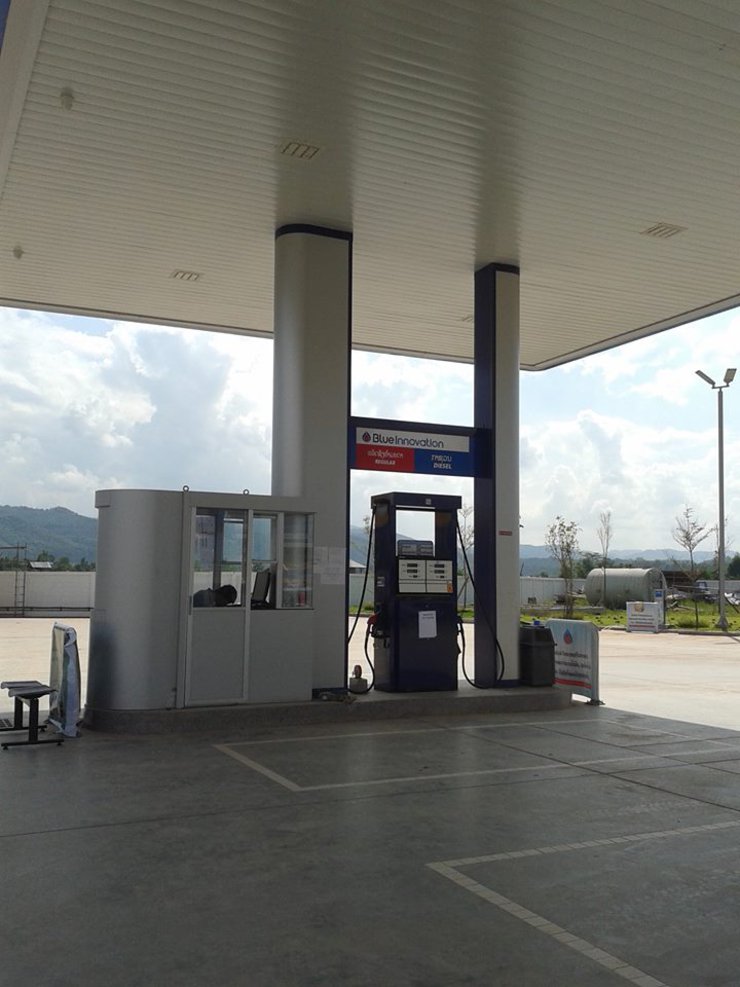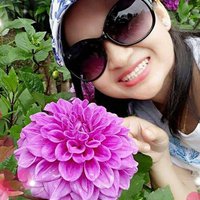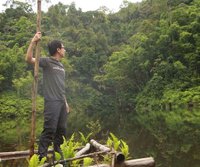This road trip started in Thailand and ended in Luang Prabang, Laos. The journey took place in October and lasted for 3 nights and 4 days. The travelers spent one night in Nan, Thailand, before crossing the border into Laos the next morning. They entered Laos through the Huay Kon checkpoint in Nan Province. The trip was inspired by the噂of the beautiful natural scenery in Laos. The travelers wanted to experience the natural beauty, traditional houses, and atmosphere of the Lao countryside. They decided to drive a pickup truck for their journey. Fortunately, they had a close friend who is an engineer in Hongsa, Laos, who helped them plan their trip and made their journey more convenient. The route they took was from Nan to Hongsa to Xayaburi to Luang Prabang. Before the trip, they obtained a vehicle passport from the provincial transport office for 150 baht and an international license plate for around 100 baht. They also brought their driver's licenses.
Upon reaching the Huay Kon checkpoint, both individuals and vehicles require a visa for entry into Laos. Importantly, it is mandatory to obtain vehicle insurance within Laos. This insurance, costing approximately 200 Baht, is crucial in the event of an accident to avoid complications. Without vehicle insurance, being apprehended by Laotian police can lead to significant issues. Therefore, it is highly recommended to secure this insurance before embarking on your journey.

After completing the border crossing formalities, we embarked on our journey to Mongsa. The road from Huay Kon checkpoint to Mongsa is in excellent condition, thanks to the Thai government's construction efforts. Mongsa is home to a coal-fired power plant that generates 90% of the electricity sold to Thailand, making it the largest power plant in Laos.



The distance from Thailand's Huay Kon checkpoint to Mongsa is approximately 30 kilometers.

Hongsa is a relatively modern town with a PTT gas station and an Amazon coffee shop. Travelers are advised to fill up their tanks here, as gas stations become scarce beyond Hongsa. This gas station is the most modern along this route.

Amazon is also available, so coffee lovers will be happy.

The restrooms are clean. Please complete your business before continuing your journey to Xayaburi.

On the way home from school, I encountered Lao girls returning home. The atmosphere here is charming. Most of them ride bicycles and hold umbrellas, dressed modestly.

The road from Xayaburi to Luang Prabang is beautiful, with abundant natural beauty and lush forests. After leaving Hongsa, the road narrows and becomes winding. Drive slowly and enjoy the scenery.

Along the way, we encountered elephants, a common sight throughout Xayaburi District. We learned that they are used to help haul timber from the forest, as the district boasts abundant forest resources.


The lush forests along the road are truly a sight to behold.

The road from Xayaboury District to Luang Prabang offers stunning views, particularly from the bridge crossing the Nam Hung River. This bridge provides a picturesque vantage point to admire the surrounding landscape.



The houses along the road are beautifully integrated with the natural surroundings.



As dusk settles over Luang Prabang, find your accommodation and seek sustenance. Numerous restaurants line the banks of the Mekong River, catering to diverse culinary preferences. Indulge in a satisfying meal, savoring the ambiance of your chosen eatery. Afterwards, venture to Joma Bakery Cafe, a renowned establishment situated on the main road opposite MyLaoHome Hotel. Delight in their delectable cakes, priced comparably to those found in Thailand. The cafe's aesthetic ambiance provides a welcoming respite for weary travelers or those seeking a leisurely break from exploring the city.


After returning to our accommodation, we rested and prepared for our next adventure. Luang Prabang offers a wide variety of accommodations to suit all budgets, ranging from a few thousand baht to tens of thousands. We slept soundly and woke up early to participate in the traditional sticky rice alms offering. For convenience, vendors prepare sets of offerings for 150 baht each. We purchased two sets for our participation.


After offering alms, I strolled through the Luang Prabang morning market, which was brimming with fascinating and unusual sights.

His vegetables and fruits are quite large and perfect, truly appetizing.




After strolling through the market, it's time to grab a bite to eat. In Luang Prabang, a well-known breakfast spot located right on the Mekong River is Prachaniyom Restaurant. Let's give it a try.


The place was bustling with tourists. The porridge was delicious, and it cost 60 baht. However, the deep-fried dough sticks were very hard. They were much better back home, where they were soft and crispy.

I came across a grandmother selling sticky rice in bamboo tubes. She was so adorable that I decided to support her by buying one. Each tube costs 30 baht.

After breakfast, we visited Wat Xieng Thong, located near the confluence of the Mekong and Khan Rivers. This significant Luang Prabang temple is considered a jewel of Lan Xang architecture. The entrance fee for tourists is approximately 100 Baht per person.




The rear wall of the ordination hall is adorned with a large bodhi tree design created from stained glass. The side walls are decorated with beautiful animal figures from literary works.

"The Royal Funeral Chariot Pavilion" houses the royal palanquin, chariots, and other vehicles of Her Royal Highness Princess Srisavang Vadhana. It is a beautiful golden structure.

After visiting the temple, we rented a boat to see the scenery on both sides of the Mekong River and head to Tham Ting. We chartered a boat for the trip, which cost around 1,800 baht, depending on negotiation. The life jackets were not of good quality, being quite old and thin. They did not provide much support, so if you have small children or are not a strong swimmer, it is advisable to check the life jackets before boarding or bring your own.




Enjoying the breeze and the scenic views of both sides of the Mekong River while riding a boat.

Children playing joyfully in the Mekong River, swimming like fish. I envy their lives, surrounded by beautiful nature every day. I gave them some pocket money to share, and they were overjoyed.


We have arrived at Tham Ting Cave. Get ready to disembark and explore the cave.

Walk a little further, it's not far.


**Tham Ting Cave** is located in a majestic mountain overlooking the Mekong River, opposite Ban Pak Ou. In ancient times, it was a sacred place for worshipping spirits, including the sky spirits, the spirits of the earth, and the guardian spirits of Tham Ting. Numerous Buddha statues have been discovered in the cave.




After enjoying the beauty of the Mekong River, we drove to **Kuang Si Falls**, a renowned waterfall known for its stunning beauty. Visiting during the rainy season in October, we were greeted by a magnificent spectacle of cascading water. The name "Kuang Si" translates to "young deer with newly grown antlers," reflecting the presence of these majestic creatures in the surrounding national forest reserve. Located approximately 32 kilometers from Luang Prabang, the falls cascade over limestone formations, creating a mesmerizing emerald green hue. Due to its popularity, a short walk from the entrance is required, with an entrance fee of approximately 300 meters and 50 Baht per person. The breathtaking beauty of the falls, with its crystal-clear water, exceeded our expectations.





In Luang Prabang, there is a local dish that I particularly enjoy, which is deep-fried river fish. The staff referred to it as "pla klet," and it was incredibly fresh and delicious. It had no fishy odor and the meat was tender and flavorful. Other dishes, such as various tom yum soups, were not as spicy as those found in Thailand, tending towards a milder flavor that might be more suitable for foreign tourists, especially Westerners. However, the "pla klet" is a must-try for me whenever I visit Laos, and it typically costs around 100 baht per plate.

The most commonly found and affordable option is Lao beer.

As dusk settled over Luang Prabang, we ascended Mount Phousi to admire the panoramic views and pay homage to the sacred That Phousi. Perched atop a 150-meter hill in the heart of the city, the stupa offers breathtaking vistas of Luang Prabang and the majestic Mekong River. The 328 steps leading to the summit are shaded by fragrant champaca trees (Laos' national flower), also known as plumeria in other parts of the world. Phousi, which translates to "mountain of the hermits," provided a glimpse of the city's charm as darkness enveloped the landscape. The limited visibility resulted in blurry photographs, but the experience left an indelible mark on our memories.



After paying respects at Phra That Phu Si, we strolled through the bustling Night Bazaar surrounding the temple. The area boasts numerous fruit juice stalls, offering a refreshing respite from the Laotian heat. Unlike commercially produced juices, these are made with real fruit, boasting a wide variety of flavors. Each glass costs between 40-50 baht and is freshly blended without added sugar. The abundance of fresh fruit is a sight to behold, with dragon fruit, mangoes, star fruit, and even avocados on display.

After a satisfying and enjoyable walk, we returned to our accommodation to prepare for our journey with Thai the next day. This concludes our brief review of this trip, which was another memorable one.

Continue to Vang Vieng-Nam Song in this trip.^^ https://th.readme.me/p/7780
Follow our small travel page on Facebook for a collection of places we've visited. Page: ไปแอ่วกัน Fun Trips. Click here to visit ไปแอ่วกัน Fun Trip.
ไปแอ่วกัน Fun Trip
Friday, October 4, 2024 3:12 PM




